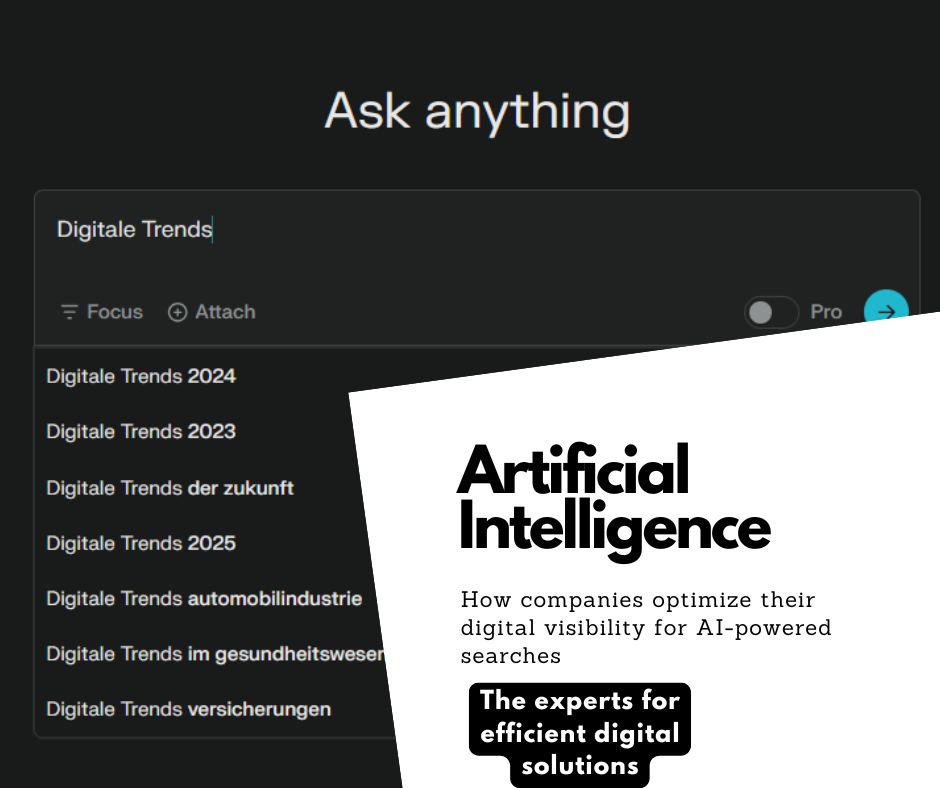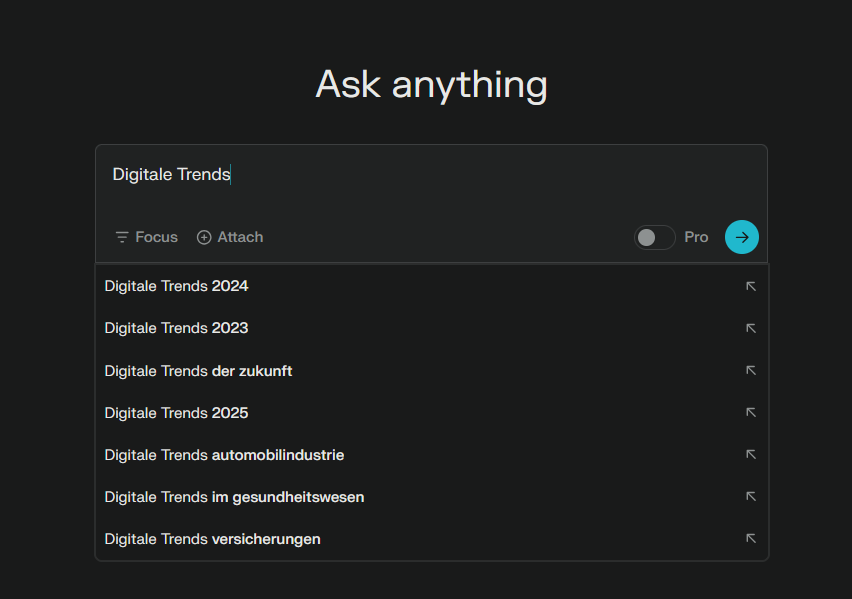Content optimization for AI search – How companies optimize their digital visibility for AI-powered searches

The way people search for information is currently undergoing a fundamental change. ChatGPT, Perplexity and other AI-supported search engines are not only revolutionizing the way people search for information, but are also presenting companies with completely new challenges when it comes to content optimization. While traditional SEO remains relevant, AI-supported search requires a complete rethink of content strategy.
Traditional keyword optimization is giving way to context-based content creation that focuses on semantic connections and factual precision. Instead of individual search terms, AI systems process natural language and provide nuanced, contextualized answers. This development is not only presenting marketing teams with new challenges – it is fundamentally changing how companies need to design their digital presence.
The speed of this transformation is particularly interesting: while it used to take months to adapt to Google updates, changes in AI models take place almost in real time. This requires companies to be more agile in their content strategy than ever before. The good news is that those who set the right course now can secure a significant competitive advantage. Unlike traditional search engines, there are still no established best practices for AI search – the market is open to innovators.
Market development and relevance
The figures speak for themselves: over 40% of Generation Z already use AI-supported search engines as their primary source of information. For companies, this means an urgent need for action, as traditional SEO strategies fall short here. SMEs in particular are facing the challenge of adapting this new technology with limited resources.
The advantages of early adaptation are obvious: companies that align their content strategy with AI search now will secure a significant competitive advantage. Our analyses show that early adopters achieve on average 180% higher visibility in AI-powered search results.


Technical basics and optimization strategies
AI search engines work in a fundamentally different way to traditional search engines. Instead of individual keywords, they analyze the semantic context and the factual precision of content. They use advanced natural language processing (NLP) models that not only understand the text, but also its meaning and context. These AI systems evaluate content according to its quality, topicality and, above all, its ability to precisely answer complex user queries.
Four main factors are decisive here
Structured data formats
Verifiable sources
Semantic networking of information
Verifiable sources
In product development, AI-supported systems can help to conduct market research and develop innovative products. AI algorithms analyze trends and customer feedback to generate new product ideas. Examples:
Multimodal content integration
Structured preparation
– Implementation of a clear information hierarchy
– Use of HTML5 semantic elements (article, section, nav)
– Consistent formatting and document structure
– Machine-readable content blocks with unique identifiers
– Integration of FAQ structures for frequent user queries
Semantic depth
– Development of comprehensive topic clusters
– Integration of expert knowledge and technical terms
– Development of thematic knowledge trees
– Contextual linking between related content
– Consideration of different user intent scenarios
Factual precision
– Regular content audits to check that content is up to date
– Implementation of a fact-checking process
– Versioning of changing information
– Clear labeling of opinions vs. facts
– Systematic source checking and documentation
Multi-format strategy
– Synchronized content delivery via different channels
– Responsive design approach for different end devices
– Integration of interactive elements
– Automatic generation of content summaries
– Cross-platform content optimization

When implementing these strategies, it is important to understand that AI search engines are constantly learning and evolving. This requires a dynamic content management system that can quickly adapt to new requirements. The balance between technical optimization and user-oriented content is particularly important – because ultimately, the content must be valuable for both AI systems and human readers.
Another critical aspect is performance measurement. Unlike traditional SEO, where rankings and traffic are clear indicators, AI search optimization requires new KPIs:

Case study 1: E-commerce transformation
A leading e-commerce retailer approached us with a clear challenge: despite strong Google rankings, visibility in AI searches was well below expectations. Especially for specific product queries through ChatGPT, competitors were mentioned preferentially.
Background:
Our technical analysis identified three key weaknesses:
Unstructured product descriptions
- Inconsistent formatting
- Missing technical specifications
- Inconsistent product attributes
Missing semantic links
- No linking of related products
- Missing category hierarchies
- Lack of integration of use cases
Lack of data validation
- Outdated product information
- Contradictory technical specifications
- Missing references
Solution
Together with the responsible content agency, we developed a comprehensive content restructuring:
Implementation of a semantic product database
- Development of a standardized data model
- Integration of Schema.org markup
- Automated quality inspection
Creation of contextual links
- Category-based product links
- Integration of application scenarios
- Linking compatible products
Integration of structured product data
- Standardized technical specifications
- Uniform attribute structure
- Automatic update processes
Implementation process
- Sprint 1: Data analysis and model development (3 weeks)
- Sprint 2: Technical implementation (4 weeks)
- Sprint 3: Content migration and QA (5 weeks)
- Sprint 4: Optimization and fine-tuning (4 weeks)
Result andmeasurable success:
Key-Learnings
- Data quality is crucial
- Consistent structures are more important than scope
- Automated validation saves resources in the long term
- Semantic relationships pay off
- Contextual links improve understanding of AI
- Use cases increase relevance
- Agile implementation works
- Fast iterations enable early optimization
- Continuous monitoring is essential
Case study 2: B2B industrial company
An established industrial equipment manufacturer was faced with the challenge of optimizing its complex technical documentation and product information for AI searches. Despite a high level of technical expertise, their solutions were hardly found in AI-supported searches, especially for specific technical queries.
Background:
The detailed analysis revealed four key challenges:
Complex technical documentation
- PDF-heavy information structure
- Inconsistent documentation standards
- Lack of digital accessibility
Isolated knowledge repositories
- Separate systems for product and application knowledge
- No link between documentations
- Lack of a central knowledge database
Technical language barriers
- Highly technical jargon
- Missing translation into user language
- Lack of contextualization
Outdated content structures
- Static HTML pages
- No structured data
- Missing API interfaces
DMG solution approach:
We developed a holistic strategy for digitalization and AI optimization:
Development of a semantic product database
- Development of a central knowledge graph
- Implementation of Industry 4.0 standards
- Integration of technical specifications
Knowledge transfer framework
- Multi-layered content model
- Automatic translation into different levels of technicality
- Dynamic FAQ generation
Technical modernization
- Automated documentation processes
- Headless CMS Implementation
- API-first architecture
Implementation process
- Phase 1: System analysis and design (6 weeks)
- Phase 2: Database development (8 weeks)
- Phase 3: Content migration (10 weeks) Phase
- 4: System integration (6 weeks)
Result:
- 85% better findability in Perplexity
- 120% more qualified leads through AI searches
- 45% reduction in documentation maintenance time
Key-Learnings
Integration is the key
- Linking technical and marketing content
- Uniform database as a basis
User orientation despite complexity
- Technical precision does not have to be incomprehensible
- Multi-layered information processing works
Change management is crucial
- Early involvement of technical editors
- Continuous training of the content teams


The AI revolution is not only changing how we search, but also how companies are found. Those who fail to act now will be left behind. At DMG, we support our customers in successfully mastering this transformation.
Till Neitzke
DMG as your partner
As experts in digital transformation, we are your strategic partner on the path to optimal AI search performance. With over 50 successful implementations in the enterprise and SME sectors, our interdisciplinary team combines technical expertise with practical implementation experience.
Needs analysis and strategy development
Technical implementation

Training courses and workshops
Continuous optimization
Conclusion and your next step
Optimizing for AI search is not an option, but a necessity. Companies that act now will secure decisive competitive advantages. It is important that implementation is systematic and data-driven.
Your next step
Use our free quick check to analyze your current content performance in AI searches. Make an appointment with our experts now and secure a competitive edge in AI-supported search.
- Download whitepaper: “AI Search Optimization – A Practical Guide”
- Free quick check of your content performance
- Individual strategy consulting
Contact us today – together we will develop your optimal strategy for the AI-supported future of information search.

Successful together in the digital transformation –
Your introductory meeting with DMG
In our introductory meeting we will discuss
- what your current challenges are in digital projects
- how other companies have done it and how you can use this to your advantage.
- what needs to be done now and whether we are the right people for the job.
[ameliastepbooking]
